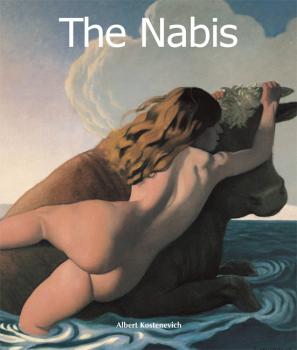Albert Kostenevitch
Список книг автора Albert KostenevitchBonnard und die Nabis
Bonnard, Vuillard, Roussel, und Denis, die bekanntesten Vertreter der Nabis-Gruppe, revolutionierten den Geist der dekorativen Techniken während einer der produktivsten Perioden der französischen Malerei. Beeinflusst von Odilon Redon, Puvis de Chavannes, der populären Volkskunst und japanischen Holzschnitten, waren diese Postimpressionisten vor allem eine Gruppe von Freunden, die dem gleichen kulturellen Umfeld angehörten. Jedoch gerät die innere Einheit der Gruppe des Öfteren durch den wachsenden Individualismus ins Wanken. Die hier vorgestellten Werke zeigen eine breite Palette von wundervoll poetischen Ausdrucksvarianten: Naiv bei Bonnard, ornamental und geheimnisvoll bei Vuillard, sanft und verträumt bei Denis, herb bis zur Bitterkeit bei Vallotton – der Verfasser lässt uns am innersten Leben der Künstler teilhaben und vor unseren Augen erschließen sich die Quellen ihres schöpferischen Talents.
Die Nabis
Pierre Bonnard war der führende Kopf einer Gruppe postimpressionistischer Künstler, die sich selbst «„die Nabis“» nannten, ausgehend vom hebräischen Wort für «„Prophet“». Unter dem Einfluss von Odilon Redon, Puvis de Chavannes, zeitgenössischer Symbolik und japanischer Holzdruckkunst revolutionisierten Bonnard, Vuillard, Vallotton und Denis, um nur die bekanntesten zu nennen, den Geist des Kunsthandwerks zu einer Zeit des Höhepunkts der französischen Malerei. Auch wenn die zunehmende Individualisierung ihrer Werke die Einheit der Gruppe bedrohte, waren die Nabis doch in erster Linie eine Gemeinschaft enger Freunde. Die in diesem Buch präsentierten Kunstwerke reichen von Bonnards Arglosigkeit, Vuillards dekorative und mysteriösen Bildern, bis hin zu Denis' weichem Schmachten und Vallottons beinahe bitterer Grobheit – sie alle lassen uns eintauchen in eine Fülle künstlerischer Brillanz.
Bonnard et les Nabis
Pierre Bonnard était le chef d’un groupe de peintres post-impressionnistes. Ils se nommèrent eux-mêmes les Nabis, du mot hébreux signifiant ‘prophète’. Bonnard, Vuillard, Roussel, Denis, les plus illustres des Nabis, ont révolutionné l’esprit des techniques décoratives durant l’une des époques les plus riches de la peinture française. Influencés par Odilon Redon, Puvis de Chavannes, l’imagerie populaire ou les estampes japonaises, ces post-impressionnistes furent avant tout un groupe d’amis fréquentat les mêmes milieux culturels. L’individualisme croissant de leurs créations ébranla souvent l’unité du groupe. Bien que liés par une même philosophie, leurs oeuvres divergeaient nettement. Cet ouvrage permet de les comparer et de les mettre en perspective les unes avec les autres. Les oeuvres présentées dans cet ouvrage offrent une palette d’expressions merveilleusement poétiques : candide chez Bonnard, ornementale et mystérieuse chez Vuillard, doucement rêveuse chez Denis, âpre jusqu’à l’amertume chez Valloton, l’auteur nous fait partager la vie intime des artistes jusqu’à la source profonde de leurs dons créatifs.
Les Nabis
Pierre Bonnard fut le chef de file d’un groupe de peintres post-impressionnistes, lesquels se nommèrent eux-mêmes les Nabis, du mot hébreux signifiant « prophète ». Influencés par Odilon Redon ou encore Pierre Puvis de Chavannes, l’imagerie populaire ou les estampes japonaises, Bonnard, Vuillard, Vallotton, Denis, pour les plus illustres, révolutionnèrent l’esprit des techniques décoratives durant l’une des époques les plus riches de la peinture française. Et, si l’individualisme croissant de leurs créations ébranla souvent leur unité, les Nabis furent avant tout un groupe d’amis. Les œuvres présentées dans cet ouvrage, candides chez Bonnard, ornementales et mystérieuses chez Vuillard, doucement rêveuses chez Denis, âpres jusqu’à l’amertume chez Vallotton, nous plongent à la source profonde de leurs dons créatifs.
Bonnard and the Nabis
Pierre Bonnard was the leader of a group of post-impressionist painters who called themselves the Nabis, from the Hebrew word meaning ‘prophet’. Bonnard, Vuillard, Roussel and Denis, the most distinguished of the Nabis, revolutionized the spirit of decorative techniques during one of the richest periods in the history of French painting. Influenced by Odilon Redon and Puvis de Chavanne, by popular imagery and Japanese etchings, this post-impressionist group was above all a close circle of friends who shared the same cultural background and interests. An increasing individualism in their art often threatened the group’s unity and although tied together by a common philosophy their work clearly diverged. This publication lets us compare and put into perspective the artists within this fascinating group. The works presented in this collection offer a palette of extraordinary poetic expressions: candid in Bonnard, ornamental and mysterious in Vuillard, gently dream-like in Denis, grim and almost bitter in Vallotton, the author shares with us the lives of these artists to the very source of their creative gifts.
The Nabis
Pierre Bonnard was the leader of the group of post-impressionist painters who called themselves “the Nabis”, from the Hebrew word for “prophet”. Influenced by Odilon Redon, Puvis de Chavannes, popular imagery, and Japanese woodblock printing, Bonnard, Vuillard, Vallotton and Denis (to name the most prominent members) revolutionised the spirit of decorative technique during one of the richest periods in French painting. Although the increasing individualism of their works often threatened to weaken their unity, the Nabis were above all a group of close friends. The artwork presented in this book − varying between Bonnard’s guilelessness, Vuillard’s ornamental and mysterious works, Denis’s soft languor and Vallotton’s almost bitter roughness − plunges us into the deep source of their creative talents.





